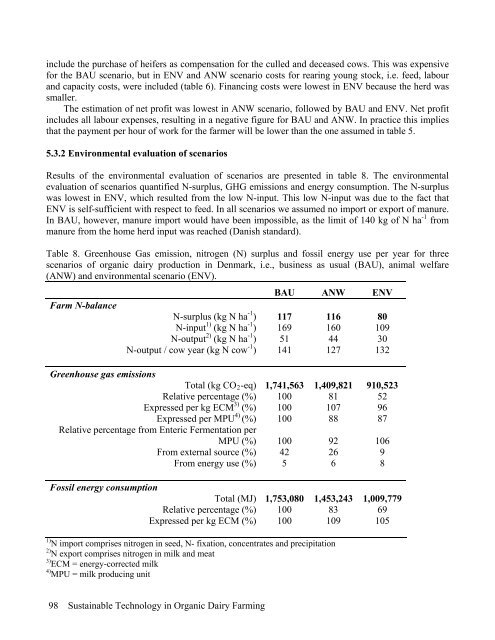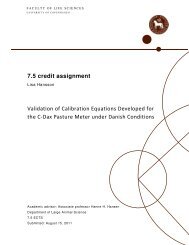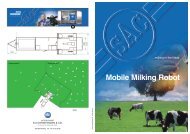Innovative Technology and Sustainable Development of Organic - 1.
Innovative Technology and Sustainable Development of Organic - 1.
Innovative Technology and Sustainable Development of Organic - 1.
You also want an ePaper? Increase the reach of your titles
YUMPU automatically turns print PDFs into web optimized ePapers that Google loves.
include the purchase <strong>of</strong> heifers as compensation for the culled <strong>and</strong> deceased cows. This was expensive<br />
for the BAU scenario, but in ENV <strong>and</strong> ANW scenario costs for rearing young stock, i.e. feed, labour<br />
<strong>and</strong> capacity costs, were included (table 6). Financing costs were lowest in ENV because the herd was<br />
smaller.<br />
The estimation <strong>of</strong> net pr<strong>of</strong>it was lowest in ANW scenario, followed by BAU <strong>and</strong> ENV. Net pr<strong>of</strong>it<br />
includes all labour expenses, resulting in a negative figure for BAU <strong>and</strong> ANW. In practice this implies<br />
that the payment per hour <strong>of</strong> work for the farmer will be lower than the one assumed in table 5.<br />
5.3.2 Environmental evaluation <strong>of</strong> scenarios<br />
Results <strong>of</strong> the environmental evaluation <strong>of</strong> scenarios are presented in table 8. The environmental<br />
evaluation <strong>of</strong> scenarios quantified N-surplus, GHG emissions <strong>and</strong> energy consumption. The N-surplus<br />
was lowest in ENV, which resulted from the low N-input. This low N-input was due to the fact that<br />
ENV is self-sufficient with respect to feed. In all scenarios we assumed no import or export <strong>of</strong> manure.<br />
In BAU, however, manure import would have been impossible, as the limit <strong>of</strong> 140 kg <strong>of</strong> N ha -1 from<br />
manure from the home herd input was reached (Danish st<strong>and</strong>ard).<br />
Table 8. Greenhouse Gas emission, nitrogen (N) surplus <strong>and</strong> fossil energy use per year for three<br />
scenarios <strong>of</strong> organic dairy production in Denmark, i.e., business as usual (BAU), animal welfare<br />
(ANW) <strong>and</strong> environmental scenario (ENV).<br />
Farm N-balance<br />
BAU ANW ENV<br />
N-surplus (kg N ha -1 ) 117 116 80<br />
N-input 1) (kg N ha -1 ) 169 160 109<br />
N-output 2) (kg N ha -1 ) 51 44 30<br />
N-output / cow year (kg N cow -1 ) 141 127 132<br />
Greenhouse gas emissions<br />
Total (kg CO2-eq) 1,741,563 1,409,821 910,523<br />
Relative percentage (%) 100 81 52<br />
Expressed per kg ECM 3) (%) 100 107 96<br />
Expressed per MPU 4) (%)<br />
Relative percentage from Enteric Fermentation per<br />
100 88 87<br />
MPU (%) 100 92 106<br />
From external source (%) 42 26 9<br />
From energy use (%) 5 6 8<br />
Fossil energy consumption<br />
Total (MJ) 1,753,080 1,453,243 1,009,779<br />
Relative percentage (%) 100 83 69<br />
Expressed per kg ECM (%) 100 109 105<br />
1)<br />
N import comprises nitrogen in seed, N- fixation, concentrates <strong>and</strong> precipitation<br />
2)<br />
N export comprises nitrogen in milk <strong>and</strong> meat<br />
3)<br />
ECM = energy-corrected milk<br />
4)<br />
MPU = milk producing unit<br />
98 <strong>Sustainable</strong> <strong>Technology</strong> in <strong>Organic</strong> Dairy Farming




